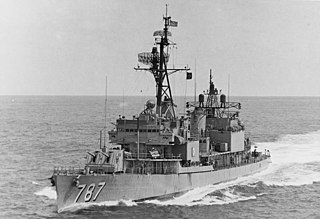
USS Arnold J. Isbell (DD-869), a Gearing-class destroyer, was the only ship of the United States Navy to be named for Arnold J. Isbell, an aircraft carrier captain during World War II. The ship was laid down on 14 March 1945 at Staten Island, New York, by Bethlehem Mariners Harbor, launched on 6 August 1945 and commissioned on 5 January 1946. Constructed too late to see action in World War II, the vessel initially served as a training ship with the United States Atlantic Fleet, before transferring to the Pacific and deploying to Korea during the Korean War and off the Vietnam coast during the Vietnam War. In 1972 Arnold J. Isbell was made part of the reserve training fleet and in 1974, sold to Greece where the ship was renamed Satchouris and served with the Hellenic Navy until being sold for scrap in 2002.

USS Brinkley Bass (DD-887) was a Gearing-class destroyer in service with the United States Navy from 1945 to 1973. She was then transferred to Brazil where she served as Mariz e Barros (D-26) until 1997. The destroyer was finally sunk as a target in 2000.

USS Towers (DD-959/DDG-9) was a Charles F. Adams-class guided missile destroyer of the United States Navy notable for action in the Vietnam War. The ship was named in honor of Admiral John Henry Towers.

USS Turner Joy (DD-951) is one of 18 Forrest Sherman-class destroyers of the United States Navy. She was named for Admiral Charles Turner Joy USN (1895–1956). Commissioned in 1959, she spent her entire career in the Pacific. She participated extensively in the Vietnam War, and was one of the principal ships involved in the Gulf of Tonkin Incident.

The second USS Henry W. Tucker (DD-875) was a Gearing-class destroyer of the United States Navy.

USS Higbee (DD/DDR-806) was a Gearing-class destroyer in the United States Navy during World War II. She was the first U.S. warship named for a female member of the U.S. Navy, being named for Chief Nurse Lenah S. Higbee (1874–1941), a pioneering Navy nurse who served as Superintendent of the U.S. Navy Nurse Corps during World War I.

USS Collett (DD-730) was a World War II-era Allen M. Sumner-class destroyer in the service of the United States Navy.

USS Hopewell (DD-681) was a Fletcher-class destroyer in service the United States Navy from 1943 to 1947 and from 1951 to 1970. She was finally sunk as a target in 1972.

USS Agerholm (DD-826) was a Gearing-class destroyer of the United States Navy. She was the only ship named for Harold Crist Agerholm, a Private First Class (Pfc.) in the 2nd Marine Division of the United States Marine Corps. He was killed during the assault on Saipan, and posthumously awarded the Medal of Honor.

USS O'Brien (DD-725), an Allen M. Sumner-class destroyer, was the fourth ship of the United States Navy to be named after Captain Jeremiah O'Brien and his five brothers, Gideon, John, William, Dennis and Joseph, who captured HMS Margaretta on 12 June 1775 during the American Revolution.

USS John A. Bole (DD-755), was an Allen M. Sumner-class destroyer of the United States Navy.

USS John W. Thomason (DD-760), an Allen M. Sumner-class destroyer, is the only ship of the United States Navy to be named for John William Thomason, Jr., a USMC officer who was awarded the Navy Cross for bravery during World War I.

USS Ingersoll (DD-652) was a Fletcher class destroyer in the United States Navy, serving from 28 June 1943 through 19 May 1974. Ingersoll saw action mainly in the Pacific Ocean Areas during World War II, and during the Korean War and Vietnam Wars.

USS Stoddard (DD-566) was a Fletcher-class destroyer of the United States Navy, named for Master's Mate James Stoddard, who was awarded the Medal of Honor during the Civil War. She was the last Fletcher to be stricken from the U.S. Navy, in 1975.

USS Wiltsie (DD-716) was a Gearing-class destroyer in the United States Navy. She was named for Irving Wiltsie. The destroyer entered service in 1946 and remained active with the United States Navy until 1977, when Wiltsie was decommissioned and sold to Pakistan in 1977. The vessel entered service with the Pakistan Navy as PNS Tariq (D165) in 1978. In 1990, the ship was renamed PNS Nazim to allow the name Tariq to be given to a newly-acquired Type 21 frigate. The ship was then transferred to the Pakistan Maritime Security Agency and used as an alongside "at sea" headquarters for the agency. Though afloat, the vessel no longer sails.

USS Henderson (DD-785) was a Gearing-class destroyer of the United States Navy, the second Navy ship of that name, and the first named for United States Marine Corps Major Lofton R. Henderson. The previous Henderson was named for Marine Corps Commandant Archibald Henderson.

USS James E. Kyes (DD-787) was a Gearing-class destroyer of the United States Navy, named for Commander James E. Kyes (1906–1943).

USS Hanson (DD/DDR-832) was a Gearing-class destroyer of the United States Navy, named after First Lieutenant Robert M. Hanson of the United States Marine Corps of Marine Fighting Squadron 215. Hanson was a quintuple ace who was awarded the Medal of Honor posthumously.

USS Bausell (DD-845) was a Gearing-class destroyer in the United States Navy during the Korean War and the Vietnam War. She was named for Marine Corporal Lewis K. Bausell (1924–1944), who was awarded the Medal of Honor posthumously for "conspicuous gallantry" during the Battle of Peleliu.

USS Ozbourn (DD-846) was a Gearing-class destroyer in the United States Navy during the Korean War and the Vietnam War. She was named for Marine Private Joseph W. Ozbourn (1919–1944), who was awarded the Medal of Honor posthumously for his "great personal valor" during the Battle of Tinian.




















